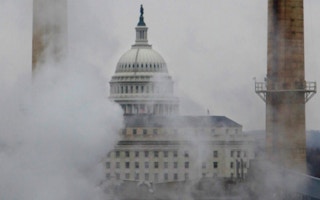President Barack Obama’s plan to combat climate change is not, as critics allege, a “war on coal,” says U.S. Energy Secretary Ernest Moniz.
In June, Obama outlined policies to lower U.S. pollution blamed for global warming, including limits on emissions from new and existing coal-fired power plants. The announcement drew fire from coal producers and lawmakers from coal-producing states.
“This action has been applauded by many as the most significant step the president can take to reduce carbon emissions,” Moniz said in a speech at Columbia University in New York. “This directive has also been derided by some as an action that is tantamount to a ‘war on coal.’ Quite the contrary, it is preparing the way for coal to have potentially a place in the low-carbon world.”
The administration has said it would revamp an $8 billion federal loan-guarantee program to help companies reduce their carbon dioxide emissions.
Obama is seeking government investment in technology to make fossil fuels, including coal, burn cleaner, he said. The new plan expands eligibility for federal loans to proposals that reduce emissions from oil and gas drilling, and for energy-efficiency efforts such as capturing waste heat from large industrial facilities to make electricity. Clean-coal projects also remain eligible for aid.
Energy diversity
Obama has described his energy policy as “all of the above,” meaning a variety of energy sources, both conventional and unconventional, will be used.
“‘All of the above’ means we will invest in the technology, research, development and demonstration so that all of our energy sources can be enabled as marketplace competitors in a low-carbon energy world,” Moniz said.
In Obama’s first presidential term, carbon pollution fell as a depressed economy led Americans to drive less and low natural gas prices prompted utilities to shutter carbon-heavy coal plants, and burn gas for electricity.
This year, coal use and carbon emissions are up — and forecast to grow in the years ahead, jeopardizing Obama’s 2009 pledge to cut greenhouse gases 17 percent by 2020.
The U.S. had been on a path to reaching Obama’s goal, with emissions last year down more than 12 percent from the peak in 2007, the steepest drop since the oil crisis of the late 1970s. Since 2006, no other country has cut its total carbon pollution by as much as the U.S., according to Obama.
Coal power
The share of coal-fired electricity fell to 35 percent of total generation last year, from 49 percent in 2007, while the share of natural-gas generation hit 30 percent. Burning coal produces twice the carbon-dioxide emissions as natural gas.
Through June, coal’s share of energy production is up to 39 percent, and natural gas is down to 26 percent as its price has risen, according to the U.S. Energy Information Administration. Emissions are now forecast to grow by 2.5 percent this year, and continue on a course of steady growth through 2040.
That projection has environmentalists worried. Carbon-dioxide emissions since the Industrial Revolution have led to a warming of the Earth’s temperature over the past 50 years, threatening to worsen forest fires, drought and coastal flooding, according to the U.S. Global Change Research Program.
“I am not here to debate what’s not debatable,” Moniz said referring to the scientific consensus around climate change. “We will focus on doing all that we can with current administrative authorities.”
Gas boom
Moniz also noted that the U.S. natural gas boom has played a major role in reducing greenhouse-gas emissions. That boom in gas production has been enabled by hydraulic fracturing, a drilling technique that has been blamed for water pollution.
“If you look at each of the issues with fracking, well completions, surface water management, methane emissions, they are manageable in the sense that one knows what one has to do,” Moniz said. “They’re not always managed so that’s where it is absolutely essential to have the best practices all the time.”








